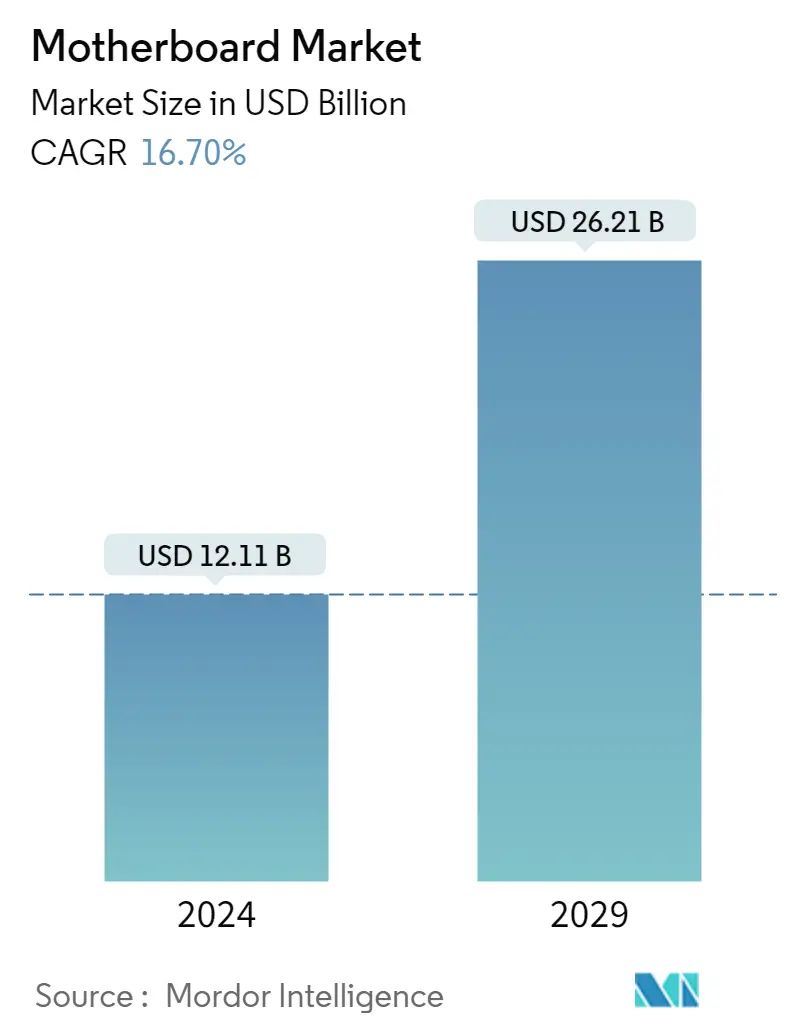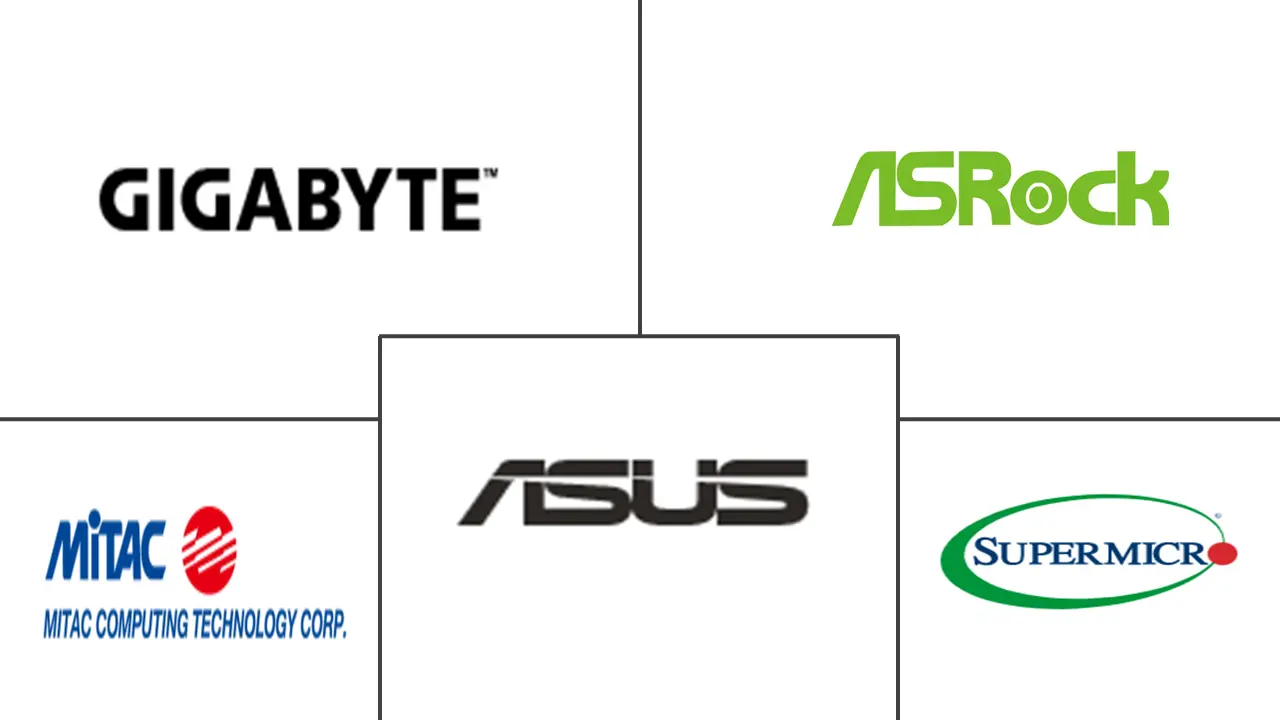Market Size of Motherboard Industry

| Study Period | 2019 - 2029 |
| Market Size (2024) | USD 12.11 Billion |
| Market Size (2029) | USD 26.21 Billion |
| CAGR (2024 - 2029) | 16.70 % |
| Fastest Growing Market | Asia-Pacific |
| Largest Market | North America |
| Market Concentration | Low |
Major Players
*Disclaimer: Major Players sorted in no particular order |
Motherboard Market Analysis
The Motherboard Market size is estimated at USD 12.11 billion in 2024, and is expected to reach USD 26.21 billion by 2029, growing at a CAGR of 16.70% during the forecast period (2024-2029).
Adopting printed circuit boards (PCBs) in connected vehicles has also accelerated the demand for motherboards in the automotive industry. Connected vehicles are fully equipped with wired and wireless technologies, making it easy to connect to computing devices like smartphones. With such technology, drivers can unlock their vehicles, start climate control systems remotely, check their electric cars' battery status, and track their cars using smartphones.
- Due to population growth, increased disposable income, and growing digitization, the increase in smartphones and computers are significant drivers for the market studied. For instance, according to the Office of National Statistics (UK), the UK manufacturer sales of PCs with a CPU and an input and output device in the same housing accounted for GBP 174.75 million (USD 235.73 million) last year. Such considerable sales of PCs in the United Kingdom would create lucrative opportunities for local and international motherboard manufacturers to develop products according to the customers' requirements.
- For instance, in October 2021, ASRock launched a new range of motherboards featuring the Intel Z690 chipset, a brand new LGA1700 socket platform to pair with the latest 12th generation Intel Core Processors, opening endless possibilities with PCI Express 5.0 and DDR5 high-speed memory.
- Motherboards intended for gaming are also gaining traction due to re-advanced BIOS configurations. This allows overclocking of the CPU and various other gaming features, enhanced compatibility with higher-end and faster components like DDR4 and DDR5 RAM, PCIe 4 GPUs, etc.
- The digital entertainment sector is constantly growing, with video games generating significant revenue. For instance, according to Entertainment Retailers Association, digital video game sales in the United Kingdom reached over GBP 3.77 billion (USD 5.08 billion) last year. Furthermore, according to GfK Entertainment, in 2021, consumers in the United Kingdom spent over GBP 1.13 billion (USD 1.52 billion) on gaming console hardware, a 32.9% growth compared to 2020. This increase is due to advanced gaming uptake among the population as COVID-19 forced people to stay at home and the next-generation console releases of the Sony PlayStation 5 and Microsoft's Xbox Series X/S.
- Several companies are launching advanced products to cater to consumers' complex demands. For instance, in May 2022, MSI introduced its latest powerful motherboard, the MAG B660M MORTAR MAX WIFI DDR4, the latest member of the MAG 600 Series. It features OC Engine and 12 + 2 Duet Rail VRM Power System to enhance and release the actual performance of 12th Gen Core processors. It also features robust cooling designs, like extended heatsinks, 2oz thickened copper PCB and M.2 Shield Frozr, and high-speed connection, like 2.5 G LAN, Wi-Fi 6E, and USB 3.2 Gen 2x2 Type-C.
- The COVID-19 pandemic enormously impacted the global and national economies. Many end-user industries have been affected, including those in electronics manufacturing. A combination of multiple resilience efforts such as supplier diversification, a global distributor network, more dedicated sourcing management, and more will provide opportunities for the motherboard market.
Motherboard Industry Segmentation
The motherboard market is segmented by form factor (ATX, Micro-ATX, Mini-ITX), end-user industry (industrial, commercial), and geography. The market sizes and forecasts are provided in terms of value (USD million) for all the above segments. Due to their wide range of applications and usage in mainly all electronic components, motherboard manufacturers are offering their products in various form factors such as ATX, Micro-ATX, and Mini-ITX, as well as for industrial and commercial needs.
| By Form Factor | |
| ATX | |
| Micro-ATX | |
| Mini-ITX |
| By End-user Industry | |
| Industrial | |
| Commercial |
| By Geography | |
| North America | |
| Europe | |
| Japan | |
| Asia-Pacific (Excluding Japan) | |
| Rest of the World |
Motherboard Market Size Summary
The motherboard market is poised for significant growth, driven by the increasing adoption of digital technologies and the rising demand for connected devices. The integration of printed circuit boards in connected vehicles has notably boosted the demand for motherboards in the automotive sector, enabling advanced features like remote vehicle access and climate control. The surge in smartphone and computer usage, fueled by population growth and increased disposable income, further propels the market. The gaming industry, with its advanced BIOS configurations and compatibility with high-end components, is also a key contributor to market expansion. The COVID-19 pandemic has accelerated digital entertainment consumption, creating lucrative opportunities for motherboard manufacturers to cater to evolving consumer needs.
Geographically, regions like India and Germany are emerging as significant players in the motherboard market. India's robust electronics manufacturing sector, supported by government initiatives, is creating opportunities for local manufacturers to innovate and meet diverse consumer demands. Meanwhile, Germany's focus on Industry 4.0 is driving the development of highly integrated motherboard units for various applications. The North American market, with its advanced mobile infrastructure and growing adoption of 5G, is also contributing to market growth. The competitive landscape is characterized by the presence of major players like GIGA-BYTE Technology, ASRock, and ASUS, who are continuously launching advanced products to meet the complex demands of consumers and industries alike.
Motherboard Market Size - Table of Contents
-
1. MARKET INSIGHTS
-
1.1 Market Overview
-
1.2 Industry Attractiveness - Porter's Five Forces Analysis
-
1.2.1 Bargaining Power of Suppliers
-
1.2.2 Bargaining Power of Consumers
-
1.2.3 Threat of New Entrants
-
1.2.4 Threat of Substitutes
-
1.2.5 Intensity of Competitive Rivalry
-
-
1.3 Impact of the COVID-19 on the Motherboard Market
-
-
2. MARKET SEGMENTATION
-
2.1 By Form Factor
-
2.1.1 ATX
-
2.1.2 Micro-ATX
-
2.1.3 Mini-ITX
-
-
2.2 By End-user Industry
-
2.2.1 Industrial
-
2.2.2 Commercial
-
-
2.3 By Geography
-
2.3.1 North America
-
2.3.2 Europe
-
2.3.3 Japan
-
2.3.4 Asia-Pacific (Excluding Japan)
-
2.3.5 Rest of the World
-
-
Motherboard Market Size FAQs
How big is the Motherboard Market?
The Motherboard Market size is expected to reach USD 12.11 billion in 2024 and grow at a CAGR of 16.70% to reach USD 26.21 billion by 2029.
What is the current Motherboard Market size?
In 2024, the Motherboard Market size is expected to reach USD 12.11 billion.

